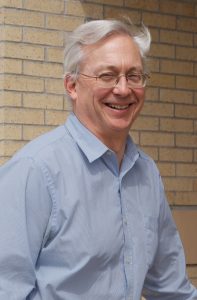It has been my privilege to serve on the faculty of the Division of Animal Sciences at the University of Missouri for 40 years. In particular, I owe a debt of gratitude to Dr. Bill Day, who I met as a PhD student at Texas A&M University. He was a member of a review team that evaluated the reproductive physiology program at A&M and he encouraged me to apply for a research/teaching position in beef cattle reproduction in the Department of Animal Husbandry. At the time, I questioned whether I was ready to initiate an independent research program, but Bill encouraged me to apply and suggested that if I was hired, I should participate in a research leave at my first opportunity. I was fortunate to be offered the position and my first day on the job was June 1, 1980. I followed Bill’s advice and conducted two yearlong research leaves in Cambridge England and Roslin, Scotland. Bill Day and Allen Garverick were excellent mentors who guided me during those early days and Al and I developed a long-term research collaboration.

When I joined the faculty, I did not realize that my scientific genealogy could be traced to the beginning of the Animal Husbandry Department at MU. In the early 1900’s, F.B. Mumford, at the University of Missouri, trained Fred McKenzie, who many consider to be the father of reproductive physiology in farm animals in the USA. At the University of Missouri, Dr. McKenzie trained LE Casida who went to become a faculty member at the University of Wisconsin. Dr. Casida had an enormous influence on the science of reproductive physiology through the numerous graduate students he trained. One of those students, trained at Wisconsin under Casida, was my major advisor, Dr. James N. Wiltbank. A picture of the Animal Husbandry Department taken in 1928 or 1929 shows F.B. Mumford, Fred McKenzie, and LE Casida as a PhD student (header photo).
A lot has changed in academics since I began my career. When I started, a faculty member was expected to develop an independent research and graduate training program, teach undergraduate and graduate courses, participate in outreach to livestock producers, and perform service to the department, college, university, and beyond. Over recent years, faculty members have become more specialized with a primary appointment in research, extension, or teaching. In regards to research, in 1980 it was still possible to function as an independent researcher without extensive collaborations. However, research today in the animal sciences is very much a team sport that requires the establishment of effective collaborations to make significant advancements. The pace of scientific discovery is so rapid and the research techniques so complex that the establishment of research teams has become a requirement.
The initiation of the Food for the 21st Century Program at MU and hiring of Dr. Mike Roberts had a profound influence on the development of the reproductive biology program. Bill Day and Mike Roberts were the initial co-leaders of the reproduction program and are largely responsible for positioning the program for the success it has experienced since that time. Mike Roberts taught young faculty members, like myself, how to write a grant, which even in the ‘80s was essential for developing a nationally recognized research program. The Food for the 21st Century Program allowed a number of talented faculty to be hired and has greatly expanded the research and graduate/postdoctoral training capability of the reproductive biology program. Furthermore, contributions from researchers within the division extend far beyond animal production to biotechnology and biomedical applications. In my view, a major strength of the reproductive biology program has been the collegiality and expertise of the faculty.
Another major change I have witnessed is in undergraduate education. When I began, the majority of the incoming students were male and now most of the students are female. The majority of incoming students today are more interested in companion animals and exotic species and less interested in food animals. Many students today have less hands-on experience, spend less time reading due to immediate access to information online, and have numerous competing interests. The preceding changes have caused us to rethink how information is presented in lectures and labs. Moving forward it will be important to design courses that allow students contact with a variety of animal species, present real-world scenarios, and engage them in problem-solving activities. It will be interesting to see what the Animal Science Department of the future looks like.
In summary, in spite of the significant changes in higher education, the opportunity to influence and inspire undergraduate and graduate students is one thing that does not change. As I reflect on my career, it is my relationships with colleagues, producers, graduate students, and undergraduate students that have been most rewarding.